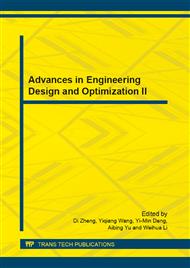p.1047
p.1051
p.1055
p.1059
p.1063
p.1069
p.1074
p.1078
p.1082
Surface Roughness Estimation in Grinding by Using Multi-Sensor Data Fusion
Abstract:
Due to the difficulty of real-time directly measuring the surface roughness of workpiece, on-line control of grinding quality remains a challenging problem. In this paper, surface roughness of slender shaft during grinding is predicted by using multi-sensor data fusion. Location of the grinding point along the workpiece axis is measured by a grating ruler while an eddy sensor mounted on the machined body provides the workpiece vibration information. The data from these sensors fuse to give an estimation of the workpiece surface roughness. Grinding experiments were carried out to validate this method and the results indicate that the prediction error of Ra is not over 0.1 um for the given setup.
Info:
Periodical:
Pages:
1063-1066
Citation:
Online since:
September 2011
Authors:
Keywords:
Price:
Сopyright:
© 2012 Trans Tech Publications Ltd. All Rights Reserved
Share:
Citation:


